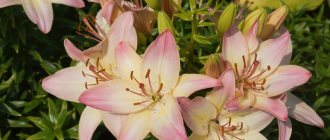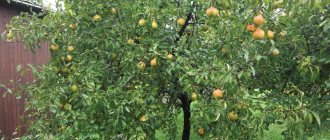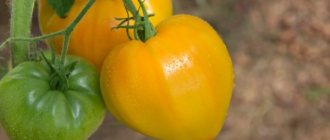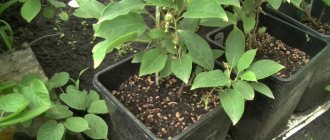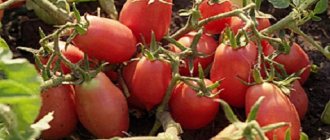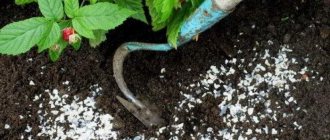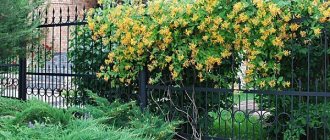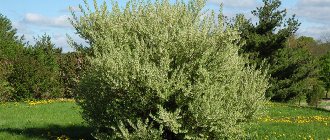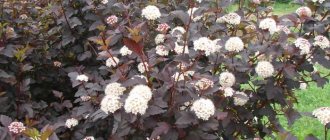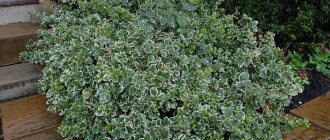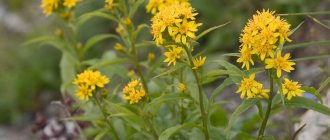History of origin and distribution of the variety
Osennyaya Yakovleva pear is an autumn-ripening variety that was bred by crossing the varieties Daughter of Blankova and Esperen's Bergamot . The work was carried out by breeders P. N. Yakovlev, S. P. Yakovlev and Z. N. Tsvetaeva - employees of the All-Russian Research Institute of Genetics and Selection of Fruit Plants named after. I. V. Michurina.
The first tests were carried out in 1949. The variety has been approved for cultivation since 1974 in the Voronezh, Kursk, and Volgograd regions and is most widespread in the regions of the middle zone.
Description and characteristics
The trees are tall (about 15 m) and fast growing . The crown is sparse and spreading. The branches droop slightly as they grow. The shape is highly rounded or broadly pyramidal.
The shoots are curved, dark brown, of medium thickness, lentils are few . The leaf blade is wide, slightly curved, medium in size, pointed at the tip. The base of the leaf is wedge-shaped, directed upward. The edges are jagged. The petioles are long, the stipules are subulate.
The variety is distinguished by its high ability to shoot - after pruning, the crown thickens greatly.
The fruits are formed on fruit rods and ringlets , and have a ribbed, broadly pear-shaped or irregular rounded-diamond shape. Average weight - 130-150 g, maximum - 250 g.
Fruits of medium ripeness are green, with a slight blush on the sunny side . Fruits of technical ripeness have a green-yellow color. The top coat color runs along a narrow part in the form of a vague carmine blush. Large brown dots are visible on the skin.
The stalks are of medium thickness and length, straight. The funnel is wide, without rust. Open cup. The saucer is shallow, wide, ribbed. The heart is oval, wide.
The seeds are large, ovoid, light brown in color , with closed seed chambers.
The pulp is oily, dense, non-grainy . The aroma is weak. The taste is melting, juicy, tender, sweet, without astringency, with a slight aftertaste of nutmeg. Tasting score - 4.8-4.9 points on a five-point system.
Biochemical composition of the fetus:
- sugar - 9%;
- acidity - 0.08%;
- vitamin C - 12 mg;
- catechins - 38.8 mg.
The fruiting period begins 5 years after planting , but there is information about later dates. The fruits are used universally: wines, preserves, jams, marmalade, compotes, candied fruits. The harvest is harvested in the second half of August and stored in the cellar until the end of October. Productivity - 30-35 kg per tree.
The level of winter hardiness is low - up to -25°C . Drought resistance is high. The variety is prone to fruit scab.
Autumn Yakovleva is used in breeding work . With her participation, the Debutante pear variety was developed, zoned in the Middle Volga region.
Interesting things on the site:
Step-by-step instructions for planting cherry plum in autumn
How should grapes be planted in the fall?
When and how to prune raspberries correctly in the fall
Technical data of the pear
Pear in Memory of Yakovlev
Description of the Autumn Yakovleva pear:
- The height of the tree ranges from 13-15 to 18 m. The crown has a round shape.
- There are a large number of leaves on the branches. They have a wedge-shaped base and a slight convexity. There are short sawtooth serrations along the edges of the leaf blade.
- The pear hybrid Osennyaya Yakovleva grows quickly, producing numerous shoots. Due to the high density of the crown, constant pruning is required.
- The development of fruits of this variety occurs on the stem ringlets and twigs.
- The shoots on the trees are wide, curved and quite thick. Painted brown. They contain a small number of lentils.
Characteristics of the hybrid fruits:
- They have the shape of a classic pear. During the ripening period, the fruits acquire an emerald color. An integumentary blush appears on the side facing the sun's rays.
- The stalk is of medium size. The calyx of this variety is open. The saucer is small in size, with small ribs. The heart is shaped like an egg. All varieties of Autumn Yakovlev have closed chambers where the seeds are located, colored brown.
- The weight of each fruit ranges from 0.12 to 0.14 kg. Some gardeners managed to obtain pears weighing up to 0.250 kg. Experiments carried out on growing the hybrid in Siberia resulted in fruits weighing from 80 to 100 g.
Pear Autumn Yakovleva
Fruiting of the Osennyaya Yakovleva variety begins from the 5th year of seedling development. The harvest is harvested after August 15-20, but most often this happens in the fall. The average weight of fruit harvested from one tree ranges from 30-35 kg. Fruits can be transported over medium distances. The variety partially pollinates itself, but breeders recommend using pollinators planted nearby for fertilization, for example, Lada or Augustovskaya pears.
The tree is frost-resistant, withstands cold from -25-28°C to -30-32°C. But in severe frosts, it is recommended to protect the plantings by fumigation (smoke), covering the plants with film or warm materials.
pear tree
The variety also tolerates dry, hot summers. The hybrid may be affected by scab. They use fresh fruits and make jams and preserves from them. If you store fruits in a cool place, the duration of their consumption increases to 70-75 days.
Advantages and disadvantages
Advantages of the variety:
- high taste qualities;
- drought resistance;
- productivity;
- stable fruiting;
- keeping quality;
- vitamin content.
Flaws:
- susceptibility to fruit scab;
- tallness;
- late fruiting;
- the need to trim the crown.
What type of pear is it?
Osennyaya Yakovleva pear is an autumn variety with a mixed type of fruiting. The taste of the variety is very high. Experienced gardeners rated the fruits 4.9 points out of 5 possible.
The variety has a large number of useful vitamins and microelements.
Pears contain organic acids, pectin, tannins, enzymes, natural sugars, and phytoncides.
The fruits are rich in phosphorus, calcium, cobalt, iron, silicon, potassium, and copper.
Characteristics of the properties of pear variety Osennyaya Yakovleva:
Preparation of planting material and soil
When cultivating the variety, standard pear farming techniques are used . It is preferable to plant in the spring. When planting in autumn in the regions of the middle zone, there is a high probability of unrooted seedlings freezing in winter.
The site is chosen on the sunny side, without drafts, with deep groundwater . On the north side, trees should be protected from piercing cold winds by the dense crown of neighboring trees or the wall of the house. At the same time, it is not recommended to place seedlings in close proximity to fences or trees so that they do not end up in the shade.
The soil must be moisture- and breathable, fertile . Black soil or loam with an acidity level of pH 5.5-6 is best suited. The plant does not develop well in alkaline soil.
Seedlings can be purchased in the spring, but in the fall the choice is much wider . This is explained by the fact that nurseries dig up seedlings en masse in the fall. In the spring, unsold copies that were left for storage go on sale.
A high-quality seedling has a well-developed root system, smooth bark without cracks . The optimal age is 1-2 years. Old seedlings do not take root well; later they begin to grow and bear fruit.
Seedlings purchased in the fall are buried in the ground until spring for better preservation . In the garden, they dig a rectangular hole, up to 30 cm deep, pour river sand on the bottom and lay the plant with the rhizome down. The top is placed on the edge of the pit. Before this, the roots are dipped in a solution of mullein and clay, then covered with sand and watered. With the arrival of cold weather, the hole is filled with soil.
Seedlings can be stored in the basement at a temperature of 0…+5°C.
Harvesting, transportability and storage of crops
As a rule, experienced gardeners try to harvest pears before the fruits reach full biological ripeness. The fact is that such pears are stored much better and, in addition, as they ripen, the fruits often do not stay on the stalks and fall off, and the so-called carrion spoils very quickly. However, the Pamyati Yakovlev variety is a rare and pleasant exception to the rule. Its harvest can be harvested both at the stage of technical ripeness and after full ripening.
In both cases, the pears are perfectly held on the tree and subsequently stored equally well. The optimal place to store the pear harvest is a cellar, the optimal container is wooden or cardboard boxes. It is best to place the fruits in them in one layer, placing the pears vertically, with the stalk facing up. This way they will deform less, which means they will remain usable longer. If these requirements are met, the Yakovlev Memory harvest harvested in October can be stored until March without any problems.
In Memory of Yakovlev is a well-tested classic. Having planted such a tree on your site, you don’t have to worry about encountering unpleasant surprises that are typical of newfangled products. Of course, this pear also has disadvantages, but still, for a novice gardener, an unpretentious variety that is resistant to various diseases is perfect.
Landing technology
Tall trees with spreading branches need space for full development. Recommended planting pattern: 4-4.5 × 5-6 m .
The pit for planting trees is prepared in the fall . Its size depends on the fertility of the soil. The lower the soil nutritional value, the larger the hole. On loam, a depression is formed with a diameter of 80 cm and a depth of 70-80 cm. On sandy soil, a hole is dug with a diameter of 1 m and a depth of 2 m.
The bottom is compacted with crushed stone, broken brick, expanded clay to prevent water stagnation . The thickness of the drainage layer is 10-15 cm.
A nutrient mixture of peat, chernozem, sand and humus (1:1:1:1) is added to the hole , 300-400 g of superphosphate and 3-4 liters of wood ash are added. The pit is covered with roofing felt, slate or thick film to prevent the nutrient mixture from being washed out by melt water in the spring.
In the spring, seedlings are dug up or taken out of storage, carefully examined and the roots are immersed in a solution of “Kornevin”, “Heteroauxin”, “Epin” to stimulate the formation of new roots .
The cover is removed from the pit, a depression is formed in the center according to the size of the rhizome and a small elevation is made . A stake 1-1.3 cm high above the ground level is driven in 15 cm from the center.
The seedling is lowered onto a hill with its root collar, and the roots are spread along the slopes . Soil is poured on top. Each new layer is compacted. The root collar should be at ground level.
After filling the hole, the seedling is tied to a stake with an elastic rope . It is important not to squeeze the bark.
A shaft 25-30 cm high is formed around the hole to retain water during irrigation.
After planting, the seedling is watered abundantly so that air bubbles come out and the soil adheres tightly to the roots. After the soil has dried, the top layer is loosened and covered with sawdust, spruce branches, compost, and straw. Mulch layer - 6-8 cm.
The central conductor of a young tree is pruned to a height of 60-80 cm , the branches are shortened by 50%.
Diseases and pests
Autumn Yakovleva has average resistance to pests and diseases of various kinds. It is necessary to treat your plant in advance for preventive purposes.
Scab
The most dangerous disease for a tree is scab. To protect the pear from scab damage when planting, you need to use only first-class seedlings and cuttings. In case of disease, affected fruits and foliage must be burned, buried or removed as far as possible from healthy plants.
Another way to combat scab is to spray the tree with freshly prepared mustard solution. To prepare the solution, you need to dissolve 100 g of mustard powder in 250 ml of warm water. Pour the mixture into a full 10-liter bucket of water.
Fungal diseases
In addition to scab, there are other diseases:
- Fruit rot. Brown rot appears on the pears, which spreads very quickly and begins to occupy almost the entire area of the fruit. To solve this problem, it is necessary to spray the tree with a solution of copper sulfate immediately after harvesting.
- Sooty fungus. It is a dark, spotted coating similar to soot. The fruits remain suitable for consumption and further processing, but their presentation, taste and shelf life are lost. To combat the disease, you need to treat the plant with an infusion of tobacco dust or soap in early spring (even before the buds open).
- Rust. Among the main signs of rust damage to a tree are red spots on the foliage. Treatment with Bordeaux mixture or copper oxychloride will help.
- Powdery mildew. When affected by this disease, the leaves acquire a powdery white coating, which over time becomes a reddish hue. To prevent powdery mildew, it is necessary to remove dried shoots and then burn them. You also need to periodically spray the tree.
In the autumn, to protect against pests, you need to strip the tree bark and whiten it, and dig up the ground around it. This operation is recommended to be performed after rain.
Growing and care
Agricultural technology for pears is standard : watering, pruning, fertilizing, disease prevention.
Watering is carried out regularly - once every 25-30 days . The first time the pear is watered is before flowering, the last time - in October. The soil is spilled to a depth of 25-35 cm. The trunk is hilled to prevent direct contact with water. This way it is possible to protect the root collar from rotting.
The soil is loosened after each watering and rain to better saturate the root system with oxygen.
Mulching retains moisture and reduces the frequency of watering and loosening . The mulch layer is regularly checked and updated - this is an ideal environment for the accumulation of beetles and slugs.
The nutrient mixture in the planting hole is depleted 3-4 years after planting. Fertilizing begins annually, using organic matter and minerals.
Feeding scheme:
- Compost, peat and humus are added in the spring for digging every 2-3 years. For 1 m² of tree trunk circle use 5-7 kg.
- Nitrogen-containing fertilizers (ammonium nitrate, urea, Nitroammofoska) are applied annually in an amount of 20-30 g/m².
- During the period of active growth of shoots and fruits, trees are fed with potassium sulfate or monophosphate in an amount of 10-20 g/m².
- Superphosphate is added in the fall for digging - 20-30 g/m².
- To support fruiting, trees are fed with a solution of mullein or chicken manure: 2 liters of liquid fertilizer are poured into 10 liters of water and left for a week in a warm place to ferment. Fertilizer consumption is 10 liters per 1 m² of tree trunk circle. Instead of mullein, green fertilizers are used (infusion of nettles, weeds, tops, any grass): 5-7 kg of raw materials per 10 liters of water.
In March, the crown is trimmed . This procedure is performed to delay the growth of branches and stimulate the growth of buds and fruits.
Important! At the end of April, trees are sprayed with Fury and Inta-Vir to prevent fungal diseases and the spread of pests.
The standard crown formation for tall trees is sparsely layered . An annual seedling is pruned to 70 cm. In the next season, a first tier of 3-4 shoots 45-50 cm high is formed. Over the next two years, a second tier of 2-3 frame branches is laid at a height of 35-40 cm from the outermost branch of the first tier. If necessary, form a third tier of 1-2 branches. After 5 years, you should get a crown of 6-8 frame branches.
There are other types of pruning:
- sanitary (removal of dry, diseased and damaged branches);
- regulating (thinning);
- supporting (shortening the length of branches to stimulate fruiting).
The last type of pruning is performed by the chasing method (shortening young shoots by 5-10 cm) or by forming shoots that replace fruiting branches.
General pruning requirements:
- The pruning tool (hacksaw, pruning shears, lopper, knife) must be sharp.
- Before starting work, the instrument is disinfected with a 1% solution of copper sulfate, 3% solution of hydrogen peroxide, 3% solution of potassium permanganate, alcohol (optional).
- After pruning, hemp and branches should not be left open - after drying, putrefactive processes develop and a fungal infection occurs. Experienced gardeners advise using the “ring” technique. The branch is cut with a hacksaw from below to 1/3 of the thickness, 25 cm away from the ring. Next, the tool is shifted 2-3 cm to the side and sawed from above. After removing the branch, the stump is sawed off along the top of the ring. A torn, uneven cut is cleaned with a knife - a smooth one heals faster. The saw cut is disinfected with brilliant green or the biological preparation “Farmayod” and covered with wood paint based on lanolin or beeswax.
How to grow pears in the middle zone (video)
The minimum period for the start of fruiting is 5 years from the moment the pear is planted in the ground. The harvests are quite abundant: up to 32 kilograms of fruit are obtained from one tree. Plants tolerate both frost (up to 31 °C) and drought. The most common disease in this variety is scab.
Varietal characteristics
The variety is stably and abundantly fruit-bearing, self-fertile. To improve the quantity and quality of the harvest, it is recommended to plant the Lada and Avgustovskaya varieties next to the Osennyaya Yakovleva variety. During cold weather, it requires mandatory shelter.
Fruits in good conditions can be preserved for up to 75 days. These pears contain a lot of useful and necessary substances for the body. Growing healthy and strong plants requires regular feeding, watering and pruning.
Planting and care
Planting seedlings has its own characteristics:
- If a seedling is purchased with a bare root system, then before planting it is necessary to remove almost all the foliage from it - literally a couple of leaves are left on the plant on each of the branches.
- It is necessary to place the plants at a distance from each other - the area required for the tree to receive adequate nutrition is at least 12 square meters.
- When planting plants, it is necessary to place superphosphate or organic fertilizer in the hole so that the tree receives a sufficient amount of nutrition.
- The seedling is not buried - the place where the root passes into the trunk should remain 6-8 centimeters above the ground.
Caring for the plant consists of the following manipulations:
- in timely pruning of branches in order to avoid thickening of the crown - the procedure is carried out in March, old branches and those with last year's flower buds are removed, the rest are simply shortened;
- Watering pears should be carried out in a timely manner, as the soil dries out - despite its good resistance to drought, the plant will not produce an excellent harvest if there is a moisture deficiency;
- in spraying (in the spring the trees are sprayed twice - in April and after the buds have formed);
- in whitewashing held in September.
Pears need to be fed in May, and the best feedings are considered to be:
- urea;
- saltpeter;
- nitrogen;
- boric acid solution;
- copper sulfate.
Reviews about the variety
Ivan: “A worthy variety that, with proper care, will please the gardener with a magnificent harvest. The tree is tall and strong, but requires regular care and treatment, otherwise it is susceptible to fungal and bacterial diseases. But the fruits taste perfect and last a long time.”
Agnia: “The trees began to bear fruit in the 7th year; they are quite painful and require regular and thorough care. Nevertheless, all the work pays off - the trees produce delicious, large, beautiful fruits.”
Pollinator varieties
The level of self-fertility of the variety has not been studied . Some sources mention partial self-fertility, so the Avgustovskaya and Lada varieties are planted next to the Osennyaya Yakovleva pear.
Cross-pollination occurs during the period of full opening of flowers . The flowering and ripening periods of different varieties often do not coincide. Flowering of Autumn Yakovleva can occur simultaneously with late summer and late autumn varieties. Trees growing at a distance of 50-60 m can cross-pollinate, so in practice the number of pollinators increases due to specimens located nearby.
History of selection
The Osennyaya Yakovleva pear variety was initially recommended for the Central Black Earth and Lower Volga regions.
The authors of the pear are three scientists who worked at the State Scientific Institution VNIIG and SPR named after Michurin - Yakovlevs Pavel Nikanorovich and Stanislav Pavlovich, Z.N Tsvetaeva.
- The test began back in 1949 .
- Date of registration and direction - 1974 .
- Recommended growing regions - Central Chernozem region - Voronezh, Kursk, Lower Volga region - Volgograd. But the plant is also recommended for cultivation in central Russia.
- The parent couple is Blankova's Daughter and Bergamot Esperan. From Daughter Blankova, Autumn Yakovleva took the ability to bear fruit on short fruit formations and autumn activity. From Bergamot Esperan - fruit aroma, taste qualities.
It should be noted that, despite the recommendations of breeders, the plant soon spread far beyond Russia. Today, pears can be found in Belarus, Moldova, Ukraine, Kazakhstan, Estonia, Latvia, and Lithuania. Temperate continental climates are considered optimal conditions for the plant.
Reviews
Reviews about the Autumn Yakovleva pear are mostly positive. Gardeners note high yields and excellent taste .
Evgeniy, Nizhny Novgorod : “I grow several varieties of pears in the garden, including Autumn Yakovleva. I don’t bother too much with pruning, I just trim off thickened branches. The trees began to bear fruit 7 years after planting. Withstands frosts down to −40°C. In dry years it produces small fruits, but just as tasty.”
Vasily, Borisoglebsk : “This variety of pears has been growing in my garden for 15 years and is actively bearing fruit. I don’t have any particular complaints, except that the tendency to scab spoils the picture a little. Knowing this feature, I carry out preventive treatment with Bordeaux mixture and spray it with “Skorom” before flowering. Pears are very tasty, sweet and easy to eat. Pulp without grains. The aroma is not bright, but for me the taste is more important.”
Pear “Autumn Yakovleva”: description of the variety and photo
The tree of this variety is fast growing, reaching great heights of more than 15 meters . It has a drooping, rounded crown. The foliage is large. The fusion of skeletal stems is good and very strong.
This variety is characterized by a high rate of shoot formation. This can lead to severe constant pruning and a large thickening of the crown.
Fruiting and yield occur on fruit twigs, as well as on stem ringlets.
The shoots of the tree are curved, thick, wide. They have a brown tint and a small number of lentils. The leaves are endowed with a wide pointed tip and the top is directed towards the top of the tree.
The base of the leaves is wedge-shaped. The convexity is not very large, the serration is short-pointed and serrated. The petiole is elongated. The stipules have an awl-shaped shape.
The following varieties also demonstrate good yield: Yakovlevskaya, Krasulya, Detskaya, Dessertnaya Rossoshanskaya and Moskvichka.
The fruits are wide and have a classic regular pear shape. During harvest, the main color is emerald green. The cover color is endowed with a beautiful blush on the sunny side.
During fruit consumption, the main shade is emerald-amber. The cover has a slight tan on 1/4 of the fruit. The stalk of pears is medium-sized, thick, without rustiness.
The cup is open type. The saucer is miniature, with slight ribbing. The heart is large, ovoid in shape. The cameras are of a closed type. The seeds are large, oval, brown in color.
The Autumn Yakovleva pear variety has many advantages, below you will see a photo of the fruits and a description of the variety.
Take a closer look at the “Autumn Yakovleva” pear variety in the photo below:
Agricultural technology
The complex of agrotechnical measures includes several points that must be followed when growing a pear - planting, watering, pruning, treatment against pests.
Landing
To plant pears on your site, it is better to take seedlings with a closed root system, sold by specialized nurseries.
Seedlings should be planted following planting rules. Otherwise, the tree will not take root or will reduce its productivity level.
Seedlings for planting should be selected without damage or disease. But the tree should also not have improperly growing branches or damage to the roots. A healthy tree is light brown in color with a reddish or greenish tint, depending on the variety. If the color is gray or black, the seedling is unsuitable for planting.
Selecting a location
The place for the future garden is chosen to be level, away from buildings and fences.
When planting, you need to step back at least 3 meters from the fence.
- It is also advisable to place pears away from other trees to avoid diseases and pests.
- Pear is considered a self-fertile variety, but to ensure pollination it is recommended to plant the Augustovskaya or Lada varieties nearby. Despite the tree's resistance to drafts, it is advisable not to create dangerous conditions - to protect it from winds and drafts.
- But the site should also be flat - without holes, since rainwater can stagnate, and Osennyaya Yakovleva does not like waterlogging.
Description
The tree reaches 15 meters in height and has a rounded crown. The density of foliage is quite large, just like shoot formation. This fact leads to abundant cluttering of the crown, which subsequently requires frequent pruning. Brown shoots are wide in size, slightly curved. The leaves have large lobes pointing upward. They have a wedge-shaped base and an elongated petiole.
Fruits are born on fruit twigs and ringlets of stems. The description and photo of the Osenaya Yakovleva pear confirm that this variety produces a stable large-scale harvest. The voluminous pear-shaped fruit has a light emerald color, the sunny side of which is always browned. The medium-sized stalk is thick enough to support a weight of up to 170 grams. Open cup. The tiny saucer has faint ribbing. An egg-shaped large heart with closed chambers and large brown seeds.
The Autumn Yakovleva pear variety has a long shelf life. It can be aged for up to 75 days at cool temperatures.
The second half of August is famous for the rich yield of the pear in question. The stability and abundance of fruits can be ensured by planting several pollinators nearby. Lada and Avgustovskaya are the varieties most suitable for this case.
Autumn Yakovleva is so prolific that pears are formed even on thin stems.
Characteristics
This pear variety is high-yielding. It bears fruit consistently . Harvesting takes place in the second decade of August.
When storing fruits in cool pear storage facilities, the consumption period can last up to 75 days.
The variety begins to bear fruit 5 years after planting the cuttings.
Winter hardiness is average.
Withstands frosts down to minus 25 degrees Celsius.
In winter, it requires shelter for the winter.
The drought resistance of the variety is very high.
